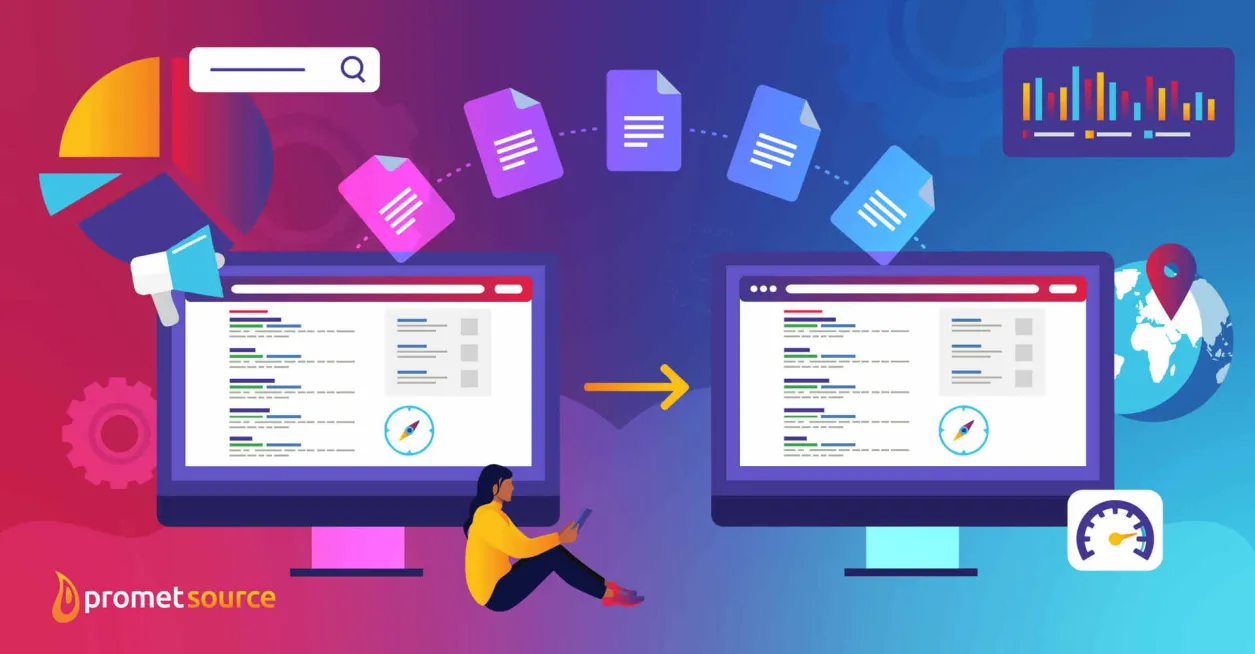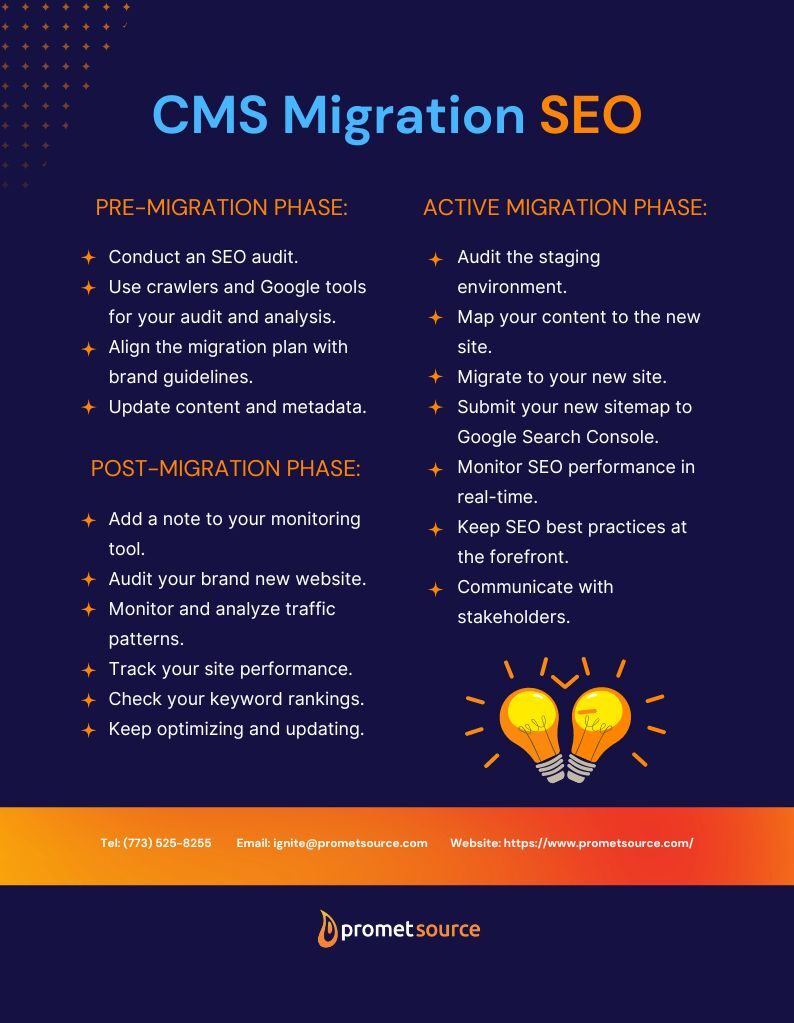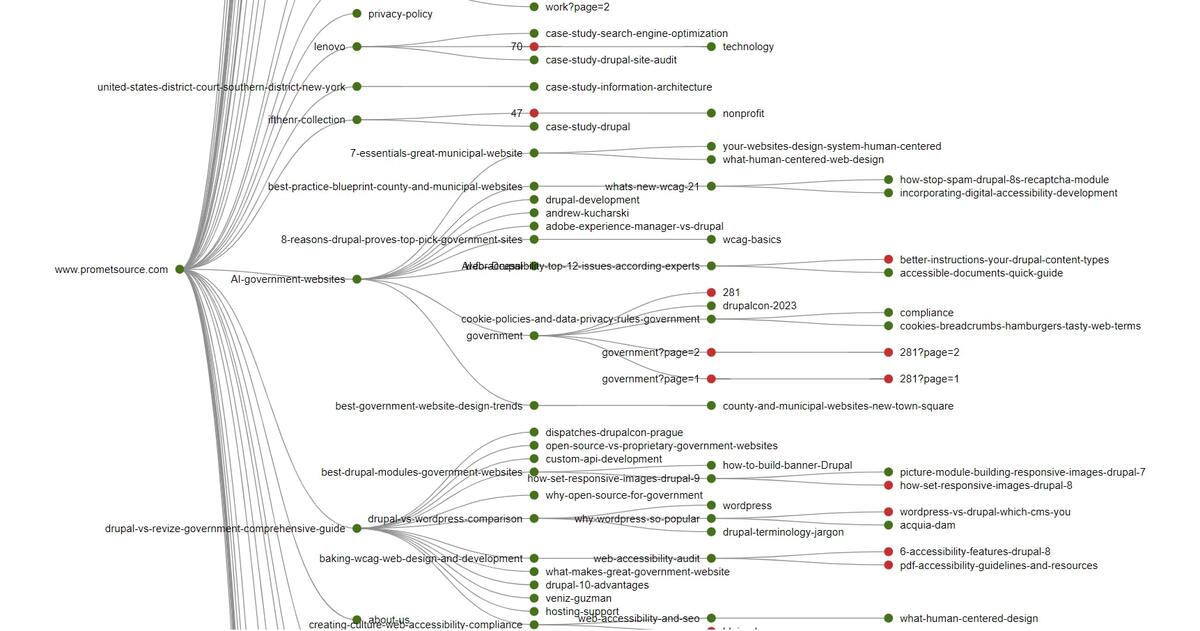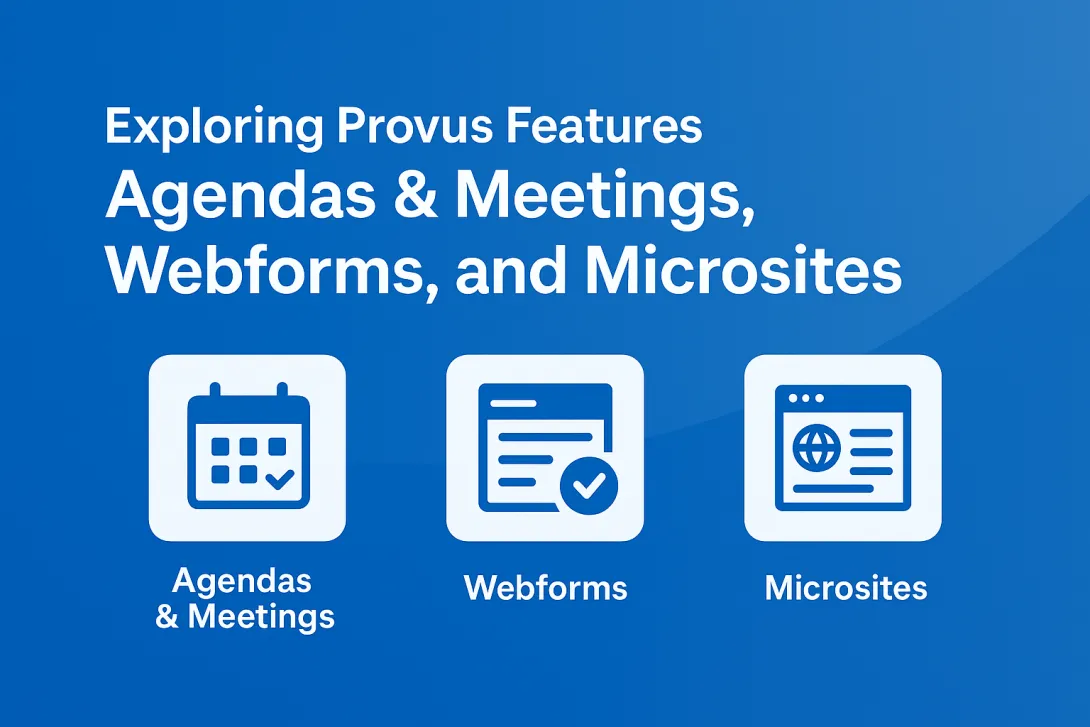The Ultimate SEO Migration Strategy Guide + Checklist

Table of Contents
Takeaway: Your website serves as the cornerstone of your online identity, and it can be very exciting when you decide to migrate your website to a new domain, platform, or design. While this transition opens doors to enhanced performance and new opportunities, it brings with it a critical challenge—preserving and enhancing your SEO during the migration process.
Here we discuss the ins and outs of website migration from the SEO point of view, focusing on maintaining and even boosting your SEO efforts. Whether you're rebranding, migrating to a different CMS, or simply moving to a more robust hosting solution, understanding the impact of these changes on your SEO is crucial.
SHARE THE SUMMARY TO YOUR STAKEHOLDERS
Key considerations in site migration SEO
- Maintaining URL structure or setting up redirects: If URL changes are inevitable, setting up proper redirects is crucial to retain the SEO value of the old pages.
- Updating internal links: All internal links should point to the correct pages post-migration.
- Ensuring URLs are mapped correctly: Your canonicals and redirects should all be listed so they don’t end up pointing to the wrong pages during migration.
- Preserving content quality: Ensure that high-value content is accurately moved and remains accessible.
- Having an SEO-friendly website from the start: Being able to audit your site and fix any issues before it goes live is an absolute must.
We’ll dive deeper into each of these in the following site migration SEO checklist.
CONTACT US FOR EXPERT SEO GUIDANCE

SEO checklist part 1: Pre-migration phase
The pre-migration phase is a critical time to set the stage for a successful transition. This involves not just technical preparations but also aligning the migration with your brand's identity in case of a redesign.
Conduct an SEO audit
Preparing for migration involves a detailed analysis of your current website's SEO performance and identifying areas that need attention during the transition.
Action plan:
- Conduct a comprehensive SEO audit to see site issues and to have a list of all your URLs.
- Identify high-value content, top-performing pages, and metadata that need to be preserved.
- Plan for URL structure changes, map URLs, and note necessary work for each URL.
- Make sure your redirects are mapped.
- Compile all this information in one sheet.

The screenshot above is a sample format for the Promet website. You can see there that each URL has their own task associated with them, whether it’s to update first, to migrate directly, to redirect, or to just delete.
We also decided to note the funnel and pillar for each URL. If that’s not something you believe will be helpful for you, then there’s no need to do it. But since we’re actively working on our content, we had to make sure those two are also noted.
Here’s a great tip:
First, make sure that you map the new menu with all categories and subcategories in the new website. Then open an excel sheet, name column A "old URL", name column B "destination URL" and start mapping manually all the categories from old to new domain. Why we need this task:
- We make work lighter for our devs with the correct redirections.
- At the end of the task we know for sure which categories will exist in the new website and which will not.
- We make sure that all the URLs will be 301 redirected, so no [accidental] 404s and we transfer the SEO juice.
Stevy Liakopoulou, SEO Specialist at Search Magic
Tools and resources for SEO audit and analysis
Leveraging the right tools can provide valuable insights into your SEO performance and guide your migration strategy.
Action Plan:
- Use crawling tools like Screaming Frog or Sitebulb to extract URLs, map current site structure, and identify SEO issues.
- Use Google Search Console and Google Analytics to benchmark website performance and to identify indexing and schema issues.
- Use Looker Studio to build your reports and add annotations for a free option.
- Alternatively, if you’re using a paid tool like Semrush to monitor your site and your keywords, add your annotations there.

Align the migration plan with brand guidelines
Your website is a reflection of your brand, and it's crucial that the migration doesn't dilute your brand identity. I know it can be exciting to suggest all the improvements you want to make, but that doesn’t mean your site can suddenly have a massive change that deviates from who the company is.
Action Plan:
- Review your brand guidelines and ensure the new site's design, content, and UX align with these standards. Work with your design team on this!
- Ensure that any changes in the website’s content still reflect your brand's voice and messaging.
- Involve your marketing and design teams in the migration planning to maintain brand consistency.
Update content and metadata
This depends on your team’s capacity, but in our case we decided to go ahead and update content and not just metadata. Remember the screenshot of the sheet earlier, and in some of them it says "Content Brief Done" in the status? That’s because we wanted to make sure that we make the proper updates we need to make for the content to be helpful and relevant for our target audience.
Action Plan:
- Review your sheet and begin performing the work you need to do for the content you need to update, whether that’s to create content briefs or just updating immediately.
- Update the status of the URLs in your sheet. You don’t want to be doing the same work twice.
We deemed it best to get the updates in as early as possible before migration so that we will not be migrating outdated content to our new site.
Plus, there are instances in which we thought a piece of content was salvageable, but it turns out it wasn’t, so digging into your table helps a lot.
Website migration should not be about moving 💩 to your new website! It isn't just about relocating. It's a chance to improve your website for users. Get SEO involved before and don’t treat them as a clean up crew.
Emina Demiri-Watson, Head of Digital Marketing at Vixen Digital
SEO checklist part 2: Active migration phase
The actual migration phase is where the planning and data collection you did in the previous part is put into action. Here, we'll focus on implementing key SEO strategies to maintain your rankings during the migration.
Audit the staging environment
The staging environment is a replica of your live site, and this is where client testing happens. Drupal Developer Adrian Cruz suggests that the heaviest technical work should be done in the dev environment (or local environment set in the developer’s machine—Project Manager Julie Samson explained to me that it’s not all the time that there is a dev environment, so ask your developer where they’re working) since that’s where the battery of tests are done to check site stability, then once they pass the test they’re pushed to the staging environment for the QA team to check.
So, let’s say the dev work has already been pushed to the staging environment—now, it’s time for you to perform your audit. I would suggest focusing on the more technical parts first so you can work on ticketing them before proceeding to content and on-page factors.
Action Plan:
- Do a full crawl of the staging environment and document the errors as how you normally would.
- Make sure to check for broken links, wrong redirects, missing pages, wrongful navigation, site structure errors, etc.
- Check for metadata that needs to be updated as well.
- Prioritize the technical fixes as you normally would and ticket the dev team.
- Work on the on-page factors to get them optimized before the code gets pushed to live.
I would assume that your staging environment is noindexed and blocked from crawling. If not, remind your dev team.
Map your content to the new site
The fields you have on your new site may not be the same as your old site, so you need to test your content. For example, you may have a new CTA section in your new blog page that didn’t exist before, so now you’ll have to add content to that portion of your blog. Mapping content ensures your pages don’t end up wonky.
Action Plan:
- Test each type of content you have and map them to your content type templates. For example, our case study pages have different fields from our blog content. Check your content types to see what you have.
- Tweak your pages as necessary. You might notice that a field you thought would be helpful before is just disruptive, or you may notice that you need a field and should have it implemented. Ticket to your developers accordingly.
Migrate to your new site
This is where the exciting part begins! You’ve done the work in staging, and your developers and designers have all worked hard to ensure everything works and looks great.
Action Plan:
- Implement 301 redirects for all changed URLs as per your pre-migration mapping.
- Test each redirect to ensure it leads to the correct page and that there are no broken links.
- Monitor the redirects closely for any errors and fix them immediately.
- Check your rel=canonical links and make sure they’re pointing to the right URLs!
Submit your new sitemap to Google Search Console
Made changes to your domain name or URL structure? Let Google know. Submitting your sitemaps is also a great way to monitor how Google is recognizing your URLs.
Action Plan:
- Make sure the site is indexable! Remove your blockers from the robots.txt file and your noindex tag.
- Verify all variants of your site with Google.
- Submit your new sitemap to GSC to let Google know if you have new URLs you want them to crawl.
- Don’t remove your old sitemap just yet. Eventually the URLs there will stop being indexed, then you can feel free to remove it.
Monitor SEO performance in real time
Keeping a close eye on your website's SEO performance during migration is crucial to identify and address issues as they arise.
Action Plan:
- Monitor your traffic using Google Analytics and GSC.
- Watch for significant changes in traffic, bounce rates, and other key metrics.
- Be prepared to make immediate adjustments if any unexpected drops in performance are detected.
Keep SEO best practices at the forefront
Throughout the migration process, adhere to SEO best practices to minimize the impact on your search rankings.
Action Plan:
- Ensure that on-page SEO elements like title tags, meta descriptions, and headings are correctly implemented.
- Maintain a clean and efficient site structure for easy navigation and indexing.
- Optimize new content and pages according to the latest SEO guidelines.
Communicate with stakeholders
Keeping all stakeholders informed during the migration process helps manage expectations and ensures a unified approach.
Action Plan:
- Regularly update your team, management, and other stakeholders about the migration progress.
- Be transparent about any challenges encountered and the steps taken to address them.
- Solicit feedback from your developers as needed to ensure a well-rounded migration process.
By being transparent with your stakeholders and your team, you ensure that there are no hidden surprises and everyone is aware if and when there are issues with the site or fluctuations with your rankings. This helps all of you be on top of any problems!
SEO checklist part 3: Post-migration phase
Once your website has successfully migrated, the post-migration phase begins. This critical period is about reinforcing the SEO foundations you laid earlier.
Add a note to your monitoring tool
This is an easy way to make sure you know exactly when your site got migrated. Any fluctuations in your site performance will be much easier to trace and track instead of having to guess when they started.
Action Plan:
- Build your Looker Studio report or head over to your favorite monitoring tool.
- Add your annotation to the date when you migrated your site to help you keep track of fluctuations.

Audit your brand-new website
It’s time to perform another round of testing.
Action Plan:
- Do a full crawl of the live environment and document the errors as how you normally would.
- Check if there were any issues from staging that made it to live. Make sure they get fixed.
- Make sure your redirects and links are working.
- Ensure that all high-value content is indexed and visible to search engines.
For the redirects, keep them in place for at least a year, if not indefinitely. You can change the links to the destination URLs in your content so it will be faster for your users, but the redirect settings should be kept in place.
Monitor and analyze traffic patterns
Understanding how your audience interacts with the new site gives you a hint as to how they’re experiencing your new site. Analyzing traffic patterns helps you gauge the success of the migration in terms of user engagement and SEO performance.
Action Plan:
- Monitor traffic, bounce rates, and engagement metrics using tools like Google Analytics.
- Compare pre- and post-migration data to identify any significant changes.
- Adjust your SEO strategy based on these insights to optimize performance.
Track your site performance
Is your new design slowing your page down? Are you noticing any crawl issues? Keeping track of your site performance helps you be on top of these issues if they arise.
Action Plan:
- Make sure your site audit is updated!
- Check PageSpeed Insights or GTMetrix to see your performance scores (but be aware of the differences of each tool).
- Note the recommendations and make sure to get them fixed!
Check your keyword rankings
Rankings may drop temporarily after the migration, but they should recover. If you find that you’re having issues with this, it would be good to go over your audit and see if there are any issues you missed.
Action Plan:
- If you’re actively tracking keywords, head over to your keyword monitoring tool. I recommend Semrush or SE Ranking for monitoring.
- Note the fluctuations in your keywords from before the migration to after your migration. Check if there are keywords that are not recovering and check the URLs identified for those keywords.
- Check your work for those URLs. See if they need any technical work or content work!
Keep optimizing and updating
SEO is an ongoing process. Continuously optimizing your website ensures that it remains competitive and compliant with the latest SEO best practices and search engine guidelines.
Action Plan:
- Keep up with SEO case studies and algorithm updates.
- Regularly refresh your content and analyze their performance to stay relevant and engaging for your target audience.
- Keep monitoring your site performance!
Frequently asked questions
In this section, I'll briefly answer some FAQs about SEO migration.
Why is SEO important in website migration?
How much of your website is indexed on search engines (and which pages), how easily your audience finds you, and how seamless the user experience you’re about to give your audience—all hinge on how well you manage your SEO during this transition.
A well-executed migration should maintain or improve your site's SEO performance. Without careful planning, migration can disrupt your SEO efforts and lead to:
- Loss of search engine rankings.
- Drop in organic traffic.
- Broken links and lost backlinks.
- Poor user experience due to navigation issues.
The goal of including an SEO professional in your website migration team is to ensure that search engines can easily crawl and index the new version of your site (that’s correctly migrated!), preserving the authority and trust you've built over time.
Do redirect links hurt SEO?
When implemented correctly, redirect links do not hurt SEO. They're essential for preserving your site's SEO value during migration.
Proper 301 redirects help transfer the SEO equity (and your users!) from old pages to new ones, ensuring that your hard-earned rankings aren't lost. However, it's important to implement redirects correctly and avoid redirect chains or loops, which can negatively impact your site's performance and user experience.
And of course, don't forget to replace the redirected link with the destination link in your pages!
Is deleting pages bad for SEO?
Let's say you realize you have a ton of pages weighing down your site, so you need to delete them before migration. If you're removing low-quality or outdated content that doesn't serve your users or align with your current strategy, it can actually benefit your overall SEO.
However, if you're deleting high-performing pages with valuable backlinks, it could hurt your SEO efforts. The key is to carefully evaluate each page before deletion and, when necessary, implement proper 301 redirects to relevant alternative pages to preserve SEO value.
Is changing domains bad for SEO?
Changing domains isn't inherently bad for SEO, but it does come with risks if not managed properly. A domain change can lead to temporary fluctuations in rankings and organic traffic.
However, with careful planning and execution, you can minimize these risks and potentially even improve your SEO in the long run. Key steps include:
- Implementing proper 301 redirects
- Updating internal links
- Informing Google of the change through Search Console
- Closely monitoring your performance post-migration
A domain change is an opportunity to start fresh with an improved site structure and content strategy, which can ultimately benefit your SEO (if done correctly).
Get expert guidance from Promet Source for your SEO migration
And there you have it, your step-by-step guide to SEO migration. As we’ve gone through the steps, it’s clear that SEO is not just a component of site migrations—it’s a critical driver of success. Imagine finally having the website you’ve planned for only to not find it on Google!
That’s why, from the initial stages of planning to the final touches post-migration, each step requires a thoughtful approach to ensure that your website not only retains its search engine presence but also emerges stronger and better for your users.
Are you planning a website migration and feeling overwhelmed by the SEO implications? Our team of experts is here to guide you. We offer tailored solutions, in-depth expertise, and a commitment to ensuring your website not only navigates this transition smoothly but also thrives in its new space.
Get our newsletter
Get weekly Drupal and AI technology advancement news, pro tips, ideas, insights, and more.




